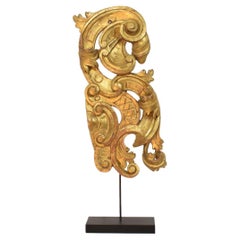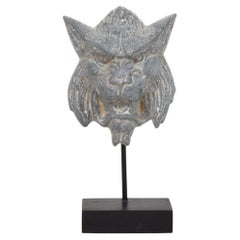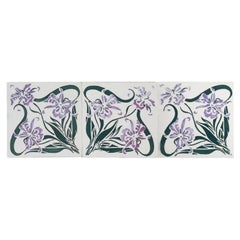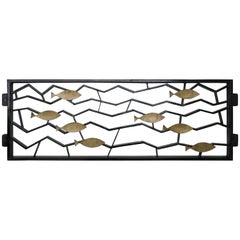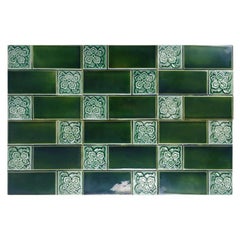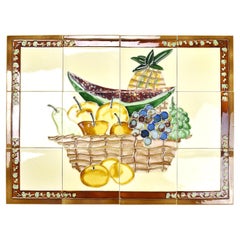Continental Europe - Architectural Elements
to
328
1,151
1,974
1,564
1,039
104
8
Height
to
Width
to
92
81
81
50
47
46
44
18
18
15
14
6
5
4
3
2
1
1
403
374
262
112
108
101
20
10
2
45
23
5
17
19
9
1
2
462
296
254
238
142
1,097
453
337
95
71
1,151
1,068
1,134
60
35
20
15
12
Item Ships From: Continental Europe
Large 18th Century Italian Hand Carved Giltwood Baroque Curl Ornament
Located in Buisson, FR
Beautiful and large handcarved giltwood baroque ornament that once adorned a chapel or a church.
Italy, circa 1750. Weathered/ small losses. Measurement includes the wooden base.
H:6...
Category
18th Century Italian Baroque Antique Continental Europe - Architectural Elements
Materials
Wood
$1,069 Sale Price
54% Off
19th Century, French Zinc Mythical Lion- Wolf Head Fragment
Located in Buisson, FR
Beautiful and rare decorative zinc item that once graced a facade, France, circa 1850-1900
Weathered but despite of its age in a good condition
Measurement here below is inclusive th...
Category
19th Century French Antique Continental Europe - Architectural Elements
Materials
Zinc
$328 Sale Price
44% Off
1 of the 40 Art Nouveau Wall Tiles Marque de Fabrique CF, Devres, France, 1920
By OTHR
Located in Rijssen, NL
1 of the 40 amazing set handmade tiles in rich dark green, lilac/purple colors. Manufactured around 1920 by Marque de Fabrique CF, Devres, France
These tiles would be charming displa...
Category
1920s French Art Nouveau Vintage Continental Europe - Architectural Elements
Materials
Ceramic
Pair of Metal Geometric Fence or Art Object with Golden Fish
By Gio Ponti
Located in Den Haag, NL
Pair of Metal Geometric fence or art object with golden fish made in Italy, circa 1950s. Priced per piece.
Category
Mid-20th Century European Mid-Century Modern Continental Europe - Architectural Elements
Materials
Metal
Large Number of Antique Glazed Relief Tiles, Belgium
By OTHR
Located in Rijssen, NL
Amazing set of handmade tiles in rich green colors. Each tile is divided into six faces. Manufactured early 20th century, Belgium.
These tiles would be charming displayed on easels, ...
Category
Early 20th Century Belgian Art Nouveau Continental Europe - Architectural Elements
Materials
Ceramic
Vintage Set of 12 Art Nouveau Style Tube Lined Tiles Fruit Basket NOS
Located in Bad Säckingen, DE
A vintage set of 12 ceramic majolica wall tile depicting a still life of a fruit basket made in tube line technique dating to the 1950s by unknown manufacturer.
The full set is in ne...
Category
1950s German Art Nouveau Vintage Continental Europe - Architectural Elements
Materials
Ceramic, Majolica
$717 Sale Price
20% Off
Collection of large version of Arne Jacobsen Solid Brass Door Handles
By Arne Jacobsen
Located in Copenhagen, DK
ARNE JACOBSEN - SCANDINAVIAN MODERN
The iconic Arne Jacobson door handles, large model 111 mm, in solid brass.
The handles were designed for the Royal SAS ...
Category
Mid-20th Century European Mid-Century Modern Continental Europe - Architectural Elements
Materials
Brass
Antique Limestone Louis XVI Fireplace Mantel
Located in Haarlem, Noord-Holland
19th century French Louis XVI style fireplace mantel in nice warm limestone.
This nice and clean looking paneled Louis XVI is adorned with two lovely stylish flowers on both sides o...
Category
19th Century French Louis XVI Antique Continental Europe - Architectural Elements
Materials
Limestone
Kitchen Drawers by Charlotte Perriand, Les Arcs 1800 ski resort Pinewood, 1960s
By Jean Prouvé, Charlotte Perriand, Pierre Jeanneret
Located in Brussels, Brussels
Kitchen drawers designed by Charlotte Perriand for Les Arcs, a ski resort in the Alps. These doors come from a kitchen of Les Arcs 1800, Résidence La Nova.
Manufactured in France in...
Category
Mid-20th Century French Mid-Century Modern Continental Europe - Architectural Elements
Materials
Pine
Antique French Limestone Fireplace Mantel
Located in Haarlem, Noord-Holland
An early 19th century French Louis xv limestone fireplace mantel.
The moulded and profiled shelf is integral to the frieze which is cent...
Category
Early 19th Century French Antique Continental Europe - Architectural Elements
Materials
Limestone
Antique French Limestone Fireplace Mantel
Located in Haarlem, Noord-Holland
Nice French Campagnard style fireplace mantel in lovely limestone.
This gem comes from central France, burgundy area.
Its perfect size make it possible to install this mantel in al...
Category
Early 19th Century French Antique Continental Europe - Architectural Elements
Materials
Limestone
1 of the 350 Handmade Antique Ceramic Tiles by Devres, France, 1920s
By Devres
Located in Rijssen, NL
This is a large set of 350 antique French handmade ceramic tiles. Manufactured by Devres, circa 1920s. Colorful pattern in yellow, red and green. These tiles would be charming displa...
Category
1920s French Folk Art Vintage Continental Europe - Architectural Elements
Materials
Ceramic
French Carved Giltwood Ornament With Winged Angel Head circa 1880-1900
Located in Buisson, FR
Beautiful handcarved giltwood winged angel ornament.
France circa 1900
Weathered
weathered.H:38cm W:44cm D:12cm
Category
Late 19th Century French Antique Continental Europe - Architectural Elements
Materials
Wood
$1,069 Sale Price
49% Off
Italian 18/19th Century Hand Carved Giltwood Acanthus Leaf Curl Ornament
Located in Buisson, FR
Beautiful handcarved giltwood acanthus leaf curl ornament that once adorned a chapel .Original period piece that due it’s high age has a beautiful weathered look.
Italy circa 1780/18...
Category
18th Century Italian Antique Continental Europe - Architectural Elements
Materials
Wood
$292 Sale Price
50% Off
Pair Italian 18/19th Century Hand Carved Giltwood Acanthus Leaf Curl Ornaments
Located in Buisson, FR
Beautiful handcarved giltwood acanthus leaf curl ornaments that once adorned a chapel .Original period pieces that due their high age have a wonderful weathered look.
Italy circa 178...
Category
18th Century Italian Antique Continental Europe - Architectural Elements
Materials
Wood
$472 Sale Price / set
50% Off
19th Century Italian Hand Carved Giltwood Gothic Style Ornament/ Fragment
Located in Buisson, FR
Beautiful handcarved giltwood gothic style ornament that once adorned a chapel or a church.
Italy, circa 1850. Weathered and small losses. Measurement includes the wooden base.
H:31,...
Category
19th Century Italian Gothic Revival Antique Continental Europe - Architectural Elements
Materials
Wood
$268 Sale Price
52% Off
Antique Austrian Door Knobs by Otto Wagner, Set of 2
By Otto Wagner
Located in Purkersdorf, AT
These door handles were designed by Otto Wagner for the Austrian Postal Savings Bank, built in 1906. These original sets offered here were replaced after World War II by newer ones (...
Category
Early 1900s Austrian Art Nouveau Antique Continental Europe - Architectural Elements
Materials
Brass, Nickel
Italian 18th Century Baroque Marble Winged Angel Head
Located in Buisson, FR
Beautiful weathered white marble angel head.
Italy, circa 1750. Good but weathered condition
Measurement here below includes the wooden pedestal.
H:29,5cm W:19cm D:12cm
Category
18th Century Italian Baroque Antique Continental Europe - Architectural Elements
Materials
Marble
$687 Sale Price
54% Off
Collection of 3, 19th Century French Zinc Flame Roof Finials
Located in Buisson, FR
Beautiful collection of 3 zinc flame roof finials.
France, circa 1850-1900. Weathered, small losses.
Measurement is individual and of the largest.
H:32/44cm W:18,5cm D:cm
Category
19th Century French French Provincial Antique Continental Europe - Architectural Elements
Materials
Zinc
$1,069 Sale Price / set
43% Off
18th Century French Carved Oak Panel Depicting An Angel On An Acanthus Curl
Located in Buisson, FR
Beautiful weathered oak panel depicting a baroque angel on an acanthus curl.
Weathered and small losses, most likely it was once part of a larger panel.
France circa 1750. treated ag...
Category
18th Century French Baroque Antique Continental Europe - Architectural Elements
Materials
Oak
$567 Sale Price
40% Off
Collection Late 18th Century French Neoclassical Carved Wooden Ornaments
Located in Buisson, FR
Beautiful collection of three 18th century neoclassical carved wooden ornaments.
France circa 1780.
Weathered, small losses
Measurements are individual and include the wooden base.
...
Category
18th Century French Neoclassical Antique Continental Europe - Architectural Elements
Materials
Wood
$687 Sale Price / set
50% Off
1 of the 350 Handmade Antique Ceramic Tiles by Devres, France, 1920s
By Devres
Located in Rijssen, NL
This is a large set of 350 antique French handmade ceramic tiles. Manufactured by Devres, circa 1920s. Colorful pattern in yellow, red and green. These tiles would be charming displa...
Category
1920s French Folk Art Vintage Continental Europe - Architectural Elements
Materials
Ceramic
HUGE Pair of 13-Light Handforged Wrought Iron Castle Chandeliers w. Gothic Crown
Located in Lisse, NL
Largest ever pair of Medieval Style chandeliers, over 5 feet tall.
With 20th century lighting as one of our specialities we have seen and sold all kinds of light fixtures, but never...
Category
20th Century European Medieval Continental Europe - Architectural Elements
Materials
Wrought Iron, Metal
Pair Large 18th Century French Neoclassical Carved Oak Ornaments
Located in Buisson, FR
Beautiful pair 18th century neoclassical carved oak ornaments.
France circa 1780.
Weathered, small losses and old repairs.
Measurements are individual and include the wooden base.
Category
18th Century Italian Neoclassical Antique Continental Europe - Architectural Elements
Materials
Oak
$1,882 Sale Price / set
55% Off
One of four "Liberty" Italian Stained Glass door- window Panel, Italy 1900 ca.
Located in Sacile, PN
One of four "Liberty" Italian Stained Glass door- window Panel, Italy 1900 c
Measure: Each door/panel measures height cm. 190, width cm. 5...
Category
Early 1900s Italian Arts and Crafts Antique Continental Europe - Architectural Elements
Materials
Lead
Pair Italian 18/19th Century Hand Carved Giltwood Acanthus Leaf Curl Ornaments
Located in Buisson, FR
Beautiful handcarved giltwood acanthus leaf curl ornaments that once adorned a chapel .Original period pieces that due their high age have a wonderful weathered look.
Italy circa 178...
Category
18th Century Italian Antique Continental Europe - Architectural Elements
Materials
Wood
$591 Sale Price / set
61% Off
1 of the 24 Handmade Majolica Sunflower Tiles Made in Italy
Located in Rijssen, NL
1 of the 24 blue and white sunflower tiles. The floral tiles are handmade and hand painted in Europe, Italy.
These tiles are particularly beautiful, the biscuit is handmade and the ...
Category
2010s Italian Continental Europe - Architectural Elements
Materials
Ceramic, Majolica, Pottery
Large Safavid 17th C. Cuerda Seca Pottery Tile from Isfahan Floral Arabesques
Located in Bad Säckingen, DE
A vibrant Safavid cuerda seca pottery tile from Isfahan, Iran, dating to the 17th century. This finely crafted example showcases the hallmark characteristics of Safavid artistry, fea...
Category
17th Century Persian Islamic Antique Continental Europe - Architectural Elements
Materials
Ceramic, Pottery
Set of 35 Pine Cone Art Nouveau Glazed Border Tiles by Le Glaive, 1920
By Le Glaive
Located in Rijssen, NL
Handmade border tiles in warm yellow, green and brown colors. With an illustration in relief of a pine cone. Manufactured around 1920 by Le Glaive, Belgium.
We have different brown ...
Category
1920s Belgian Art Nouveau Vintage Continental Europe - Architectural Elements
Materials
Ceramic
Colorful Antique Ceramic Tiles by Faiencerie de Bouffioulx, Belgium 1920s
By OTHR
Located in Rijssen, NL
Very colorful and unique handmade ceramic tiles. Manufactured by Faiencerie de Bouffioulx, Belgium, 1920s
Stylized design in wonderful bright colors green, pink, ochre and light blue...
Category
1920s Belgian Art Deco Vintage Continental Europe - Architectural Elements
Materials
Ceramic
Antique & Monumental, Finest Bronze American Bald Eagle Sculpture Door Knocker
Located in Lisse, NL
Certainly the most impressive antique door knocker on 1stdibs.
This marvelously finest handcrafted and amazing condition antique door knocker is another one of our recent great finds. Can you imagine this fine bronze eagle head on your door? Having this gorgeous bronze door knocker made as the finishing touch, would have made this a real statement piece, and it still will be. Mind you, with a unique and all hand-crafted bronze door knocker of this size, quality and beauty suddenly in your face and you too would be impressed when showing up at this front door. Especially with the fierce looking eagle holding the wreath knocker in his beak staring at you. They really don't make 'em like this anymore and we are proud to be able to offer it to the 1stdibs community in such amazing condition.
Mind you, our price for this unique antique bronze door knocker...
Category
Late 19th Century French Arts and Crafts Antique Continental Europe - Architectural Elements
Materials
Bronze
1 of the 13 Glazed Relief Tiles Produits Céramiques de la Dyle, circa 1930
By OTHR
Located in Rijssen, NL
This is an amazing set of 13 antique Art Nouveau handmade tiles, S.A. Produits Céramiques de la Dyle in Wijgmaal, Belga).
A beautiful relief and deep rich warm creme, sky blue, and g...
Category
1930s Belgian Art Deco Vintage Continental Europe - Architectural Elements
Materials
Ceramic
Original Antique Fireplace Mantel in Marble
Located in Beervelde, BE
This colorful antique fireplace chimney piece is executed in a Royal French Brêche Vendôme marble. The carving details are fine and of a high quality. I...
Category
18th Century French Regency Antique Continental Europe - Architectural Elements
Materials
Marble
Antique Louis XV Fireplace Mantel in Striking Breche Marble
Located in Haarlem, Noord-Holland
Superb 19th century Parisian Louis XV fireplace mantel in beautiful soft toned Italian Breche marble.
The serpentine shelf rests above a paneled frieze centered with an beautiful fl...
Category
19th Century French Louis XV Antique Continental Europe - Architectural Elements
Materials
Breccia Marble
Authentic French Rouge Griotte Marble Fireplace Surround
Located in Beervelde, BE
A beautiful French Louis XIV period, 18th century, original mantle piece in Rouge Griotte marble.
The marble was used in lots of historical landmarks in...
Category
18th Century French Louis XIV Antique Continental Europe - Architectural Elements
Materials
Griotte Marble
Wrought iron Fence Door Pediment / Wall Decoration
Located in Barcelona, ES
Antique spanish door fence pediment / crest in iron, hand forged, Spain, Early 20th century.
This eye-catching wall fence was entirely made by hand in forged iron. A master work of t...
Category
Early 20th Century Spanish Gothic Continental Europe - Architectural Elements
Materials
Iron, Wrought Iron
Fence Element, Attr. Gilbert Poillerat, France 1940s
By Gilbert Poillerat
Located in Greding, DE
Fence element with gold patinated decors in the form of doves, shells, and a central female figure. For comparable pieces see Lit.: Francois Baudot: Gilbert Poillerat maitre ferronni...
Category
1940s French Art Deco Vintage Continental Europe - Architectural Elements
Materials
Iron
Kiosk K67 Double Yugokiosk by Saša Müchtig for Imgrad, 1988
Located in Radomsko, Województwo łódzkie
K67 is a kiosk design created in 1966 by the Slovenian architect and designer Saša J. Mächtig.
Very good contition, preserved in its original form.
2 original canopies included.
Weig...
Category
1960s Slovenian Space Age Vintage Continental Europe - Architectural Elements
Materials
Fiberglass
Monumental Pair of Italian Neoclassical Marble Columns
Located in Rome, IT
This outstanding pair of yellow "Breccia di Siena" precious Doric marble columns raised on a white Carrara marble square base with a large molded socle above. Finely carved iconic Io...
Category
Late 19th Century Italian Neoclassical Antique Continental Europe - Architectural Elements
Materials
Marble
16th Century French Fireplace Mantel
Located in Vosselaar, BE
A monumental 16th century sandstone Renaissance fireplace mantel. Finely sculpted with a moulded beam and colomn supports. Decorated with flower motives, guirlandes and cirkels.
Lov...
Category
16th Century French Renaissance Antique Continental Europe - Architectural Elements
Materials
Sandstone
Large Plaster Architectural Ionic Capital Element, Austria, 1880
Located in Almelo, NL
Decorative large cast plaster capital of Iconic order, Austria, 1870-1880. The capital is formed by two volutes on the flanks connected with decorative...
Category
Late 19th Century Austrian Baroque Antique Continental Europe - Architectural Elements
Materials
Plaster
Mahogany and Fabric Panelled Room, Designed by Jac. van den Bosch
By Jac van den Bosch
Located in Haarlem, Noord-Holland
A rare opportunity to acquire this exquisite panelled room with original wall fabric, circa 1912.
This room was designed by Jac. van den Bosch (1868-1948), the wall fabric was design...
Category
20th Century Dutch Continental Europe - Architectural Elements
Materials
Fabric, Mahogany
Variety of Flamingo Majolica Tiles, Handmade in Italy
Located in Rijssen, NL
Gorgeous handpainted tiles with 3 different images of a pink flamingo (Phoenicopterus roseus Pallas). The tiles are hand painted and handmade in Italy...
Category
2010s European Other Continental Europe - Architectural Elements
Materials
Ceramic, Majolica
Antique Marble Fireplace with Cast Iron Stove
Located in Haarlem, Noord-Holland
Amazingly colorful French Louis XV fireplace mantel from Paris, France.
This bright and friendly pompadour style mantel comes with cast iron stove and...
Category
19th Century French Louis XV Antique Continental Europe - Architectural Elements
Materials
Marble, Breccia Marble
Early 18th Century Sphinx Florence around 1700 Sandstone Garden and Park Object
Located in Epfach, DE
Sphinx from Florence of the Early 18th Century: A Symbol of Grace and Power
The Sphinx, crafted around 1700 in Florence from sandstone, is a captivating example of garden and park a...
Category
Early 17th Century Italian Egyptian Antique Continental Europe - Architectural Elements
Materials
Sandstone
Fine Pair of Italian Carved Stone Garden Vases with Base
Located in Rome, IT
Elegant stone vases on base, decorated with finely carved mythological scenes.
Timeless decoration for you garden or interior.
Category
20th Century Italian Neoclassical Continental Europe - Architectural Elements
Materials
Stone
Alvar Aalto Sculptural Aluminium Door Handles
By Alvar Aalto
Located in Turku, Finland
Sculptural Door Handles designed by Alvar Aaltos. Made in Finland.
Material: Alumininum
Includes two handles and spacer. No connecting screws / rose screws.
Category
1980s Finnish Mid-Century Modern Vintage Continental Europe - Architectural Elements
Materials
Metal, Aluminum
$1,046 Sale Price
30% Off
French Style Wrought Iron Greenhouse with Door and Windows in White Color
Located in Marbella, ES
French style wrought iron greenhouse with doors and windows that open outwards in white color. Ready for glass panels to be installed.
Category
2010s French Continental Europe - Architectural Elements
Materials
Iron
Antique Mantel
Located in Made, NL
Antique Paonazzo Marble Chimneypiece for Sale
There is something undeniably captivating about an original antique fireplace mantel, especially one crafted from a rare and beautif...
Category
19th Century French Louis XIV Antique Continental Europe - Architectural Elements
Materials
Marble
$20,921
Antique Relief Tile Panel in the Style of J. Parentani, 1890
By Sarreguemines
Located in Rijssen, NL
Stunning Art Nouveau/ Arts & Crafts tile panel from the superb firm, Craven Dunnill, & Co., Ltd, Jackfield Salop, England, circa 1905, in a bright celadon. This quantity original jug...
Category
1890s French Medieval Antique Continental Europe - Architectural Elements
Materials
Earthenware, Pottery
Pair Italian 18/19th Century Hand Carved Giltwood Floral Ornaments
Located in Buisson, FR
Beautiful handcarved giltwood floral ornaments that once adorned a chapel .Original period pieces that due their high age have a wonderful weathered look.
Italy circa 1780/1850 , wea...
Category
18th Century Italian Antique Continental Europe - Architectural Elements
Materials
Wood
$806 Sale Price / set
50% Off
Beautiful Breche Marble Fireplace Mantel, Free Shipping
Located in Haarlem, Noord-Holland
Its a pleasure to offer this wonderful French fireplace in beautiful Italian Breche (Breccia) marble.
This early 19th century transitional (XIV - XV) mantel shows a great variety of ...
Category
19th Century French Louis XV Antique Continental Europe - Architectural Elements
Materials
Breccia Marble
16th Century oak carved Gothic Panel, Belgium
Located in Meulebeke, BE
16th century / Belgium / Letter Panel / Oak / Gothic
A finely carved Gothic oak panel from 16th-century France. This architectural fragment features graceful vertical fluting framed...
Category
16th Century Belgian Gothic Antique Continental Europe - Architectural Elements
Materials
Oak
1 of the 86 Authentic Glazed Art Nouveau Relief Tiles Rose, Belga, circa 1930s
Located in Rijssen, NL
This is an amazing set of antique Art Nouveau handmade tiles with an image of yellow rose in relief on a soft yellow background. These tiles would be charming displayed on easels, fr...
Category
1930s Belgian Art Nouveau Vintage Continental Europe - Architectural Elements
Materials
Ceramic
Arne Jacobsen Brass Door Handle Sets in Solid Brass
By Arne Jacobsen
Located in Copenhagen, DK
Arne Jacobsen - Scandinavian Modern
Original, solid brass door handles. Beautiful organic shape. An iconic design for both modern and classic interiors.
Designed for the SAS H...
Category
Mid-20th Century Danish Mid-Century Modern Continental Europe - Architectural Elements
Materials
Brass
Pair of 17th/ 18th Century Italian White Marble Baroque Ornaments
Located in Buisson, FR
Unique and very beautiful pair weathered white marble baroque ornaments. They most likely once adorned a church altar.
Original period pieces, Italy, circa 1650-1750. Weathered and s...
Category
17th Century Italian Baroque Antique Continental Europe - Architectural Elements
Materials
Marble
$1,069 Sale Price / set
52% Off
Sensational Timeless Chateau Fireplace Surround
Located in Beervelde, BE
Sensational French antique fireplace surround for the connoisseur.
Late 16th - early 17th century period chateau fireplace surround in great authent...
Category
16th Century French Louis XIII Antique Continental Europe - Architectural Elements
Materials
Limestone
Vintage wood room divider - 1960s
Located in Linkebeek, BE
Vintage wood room divider - 1960s
Wear consistent with age and use.
Room divider - Séparateur de pièce
Measures : 61,5x19,5cm H:217cm
Category
1960s Mid-Century Modern Vintage Continental Europe - Architectural Elements
Materials
Wood
Antique mantel of Breche Violetta marble from the 19th century
Located in Made, NL
A One-of-a-Kind 19th Century French Marble Mantel
This antique marble mantel from 19th-century France is a fine example of the Louis XV style, celebrated for its flowing curves and ...
Category
19th Century French Louis XV Antique Continental Europe - Architectural Elements
Materials
Marble
Small Marble Louis XVI Fireplace Mantel
Located in Haarlem, Noord-Holland
Small and elegant white marble Louis XVI fireplace mantel.
Lovely original conditions with some dicoloring in the topsheld.
Would be perfect for a...
Category
19th Century French Louis XVI Antique Continental Europe - Architectural Elements
Materials
Carrara Marble
Still Thinking About These?
All Recently ViewedMore Ways To Browse
Carved Wood Archway
Cast Stone Plaque
Church Railings
Corrugated Glass Panels
French Iron Fence
French Iron Grill
French Roof Finial
Iron Hanging Pot Rack
Large Architectural Frieze
Liberty Stained Glass
Outdoor Torchiere
Overdoor Gilt
Roof Spire
Sherle Wagner Drawer Pulls
Sicis Mosaic Tile
Stone Carved Crest
Tall Garden Finial
Terracotta Ornaments
